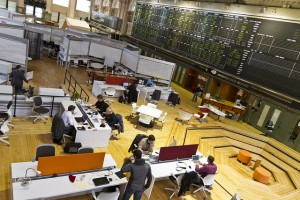Recently I visited the new offices of Microsoft in Greece. The building was totally renovated as a major change had taken place; working space was reduced and meeting rooms were increased. This was based on tele-working that allows personnel to work remotely and get together at the offices only for meetings and client presentations. Although this trend has lately slowed-down as it is shown in WorldatWork’s Special Report, it is predicted to continue to grow as technology makes it much easier and work culture gradually adapts to it (the major factor of inertia). The current financial crisis has dramatically increased the need for tele-working as it significantly brings down costs not only for the employers but for the employees as well.
During almost my 20 years of experience in commercial space design and development, I have already witnessed the square meters per employee decrease due to transition to the digital age. The space required for personal of common archiving has completely disappeared and “hot desking” or “work space hotelling” has further brought down space per person requirements. Surroundings are also not individually customized anymore but must suit all. As office space demand will continue to get squeezed by tele-working, STIRIXIS Group have started an important internal study project to predict, not only how the new office will be in 2025, but to also identify the systemic changes that this inevitable change will bring to the society, businesses, individual lives and all related activities. The change in tele-working percentage affects other areas of everyday life, including Retail. After all, working individuals are consumers and their consuming opportunities will apparently change together with their working habits. The aim of our study is to proactively help customers with their business decision, be it from real estate issues to marketing or to HR issues, to be prepared and seize the opportunities while avoiding underlying risks.
Through the tools of Systems Thinking we have by now identified a huge number of interrelated parameters that are affected by this systemic change. Apart from the obvious effect on Office Building demand, transportation demand will be affected. Retail will also have to adapt to less people being on the streets everyday and so will the F&B retail industry. But the list of changes is endless… Rush hours will be gone. People will get dressed differently; the consumption of cosmetics will decrease if we stay home to work. Think about take-away vs delivery. Or the effect on lunch-break daily cafés, or small impulse buying stores like convenience stores. Think of the extra boost to e-commerce. This simple initial list explains the inertia currently seen in statistics as the system optimization is a long and sometimes painful procedure, especially for individuals of businesses who are not agile, resist to change or have no guidance and consultation on how to manage change.
However, change is continuous and humans are social beings. This increase of tele-working will create the need for new form of meeting space, other than our house and our office, where we can get together, socialize, collaborate, buy stuff, entertain ourselves and… work, all together. A fascinating new retail multi-space will be born where all these needs will get accommodated. This is exactly what we are currently designing… Call us or stay tuned to learn more! Ah, and don’t invest heavily in office buildings as you wait…
Let me have your thoughts…


